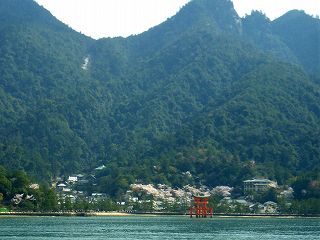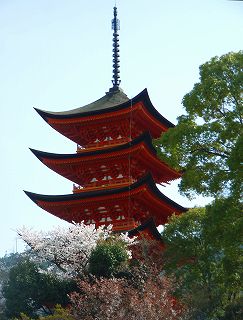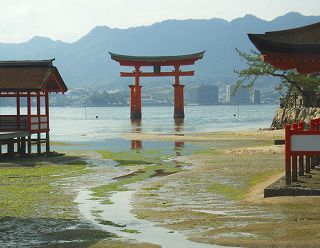Miyajima (Itsukushima Shrine and world cultural heritage)
There are Itsukushima Shinto Shrines in the island and Miyajima in the southwest of Hiroshima. It is one of the Japanese three famous views, and Ohtorii and Itsukushima Shinto Shrine are registered in World Heritage, too.
Access to Miyajima (Itsukushima Shinto Shrine)
| Address | Hiroshima Prefecture Hatsukaichi City Miyajima-cho 1-1 |
|---|---|
| Traffic and access |
It is 2 minutes on foot to the JR San'yo Main Line Miyajima entrance station getting off and the Miyajima entrance ferry terminal. Even the Miyajima entrance ferry terminal is about ten minutes by way of the west Hiroshima by-pass, San-yo car road Hatsukaichi IC getting off, and the second national roads. Ferry is operating Miyajima entrance-Miyajima pier from the Miyajima entrance to Miyajima with the ferry for about ten minutes in about 15 minutes. The fare is a child 80 yen of the one way adult 170 yen. |
| Admission fees money |
300 yen of adult and high school student and 100 yen below junior high school student |
| Map | Map in the vicinity of Itsukushima Shinto shrine |
Miyajima seen from ferry(Itsukushima Shinto Shrine)

As for Miyajima, the entire island was made the object of the belief from of old as the god. Itsukushima Shinto Shrine wished the Heike clan's prosperity by Tairano-Kiyomori and was built.
It comes to receive man of power's of the genji etc. worship, Mr. Mori restores a large-scale building of a Shinto shrine afterwards, and it has been arriving now after Heike ruins though Itsukushima Shinto Shrine was prosperous with prosper of Heike, too.
This photograph is Miyajima (Itsukushima Shinto Shrine) seen from the ferry. It was warm and cherry blossoms were full-bloomed on this day. (April 6, 2010)
Five-Storied Pagoda in Itsukushima Shinto Shrine

Five-Storied Pagoda comes into view to the left hand when arriving at the pier in Miyajima and a little walking to the west. A wild deer had been coming to ..food.. pleading without the stern where. The Iwakuni base seemed to be near and there to be a lot of tourists of the foreigner probably because of probably because of World Heritage here, too.
This photograph is an important cultural asset in Five-Storied Pagoda of the vermilion-lacquered being united for the harmony externals and Zen sect externals called create of Muromachi Period about year of 1407. Height is about 28m.
In this photograph, Five-Storied Pagoda of the pink color and the vermilion-lacquered of an empty blue, of clear up green, of green leaves full-bloomed cherry blossoms harmonizes very beautifully.
Ohtorii in Itsukushima Shinto Shrine

It comes to Ohtorii in Itsukushima Shinto Shrine when a little walking.
Ohtorii of the vermilion-lacquered that floats in the sea is huge with as many as 16.8m height. This torii is an important cultural asset set up only by the weight of the torii that is not buried foundation at the bottom of the sea but packs the stone into Shimaki of the box type and makes to the weight (about 60 tons).
It very wonders no fall at the typhoon. It seems to fall at once only in case of being making it from the tree.
Seawater seems to pull it to Ohtorii of the ebb tide it.
"Maroudosya-haraedono" and Five-Storied Pagoda in Itsukushima

The photograph is the front and Five-Storied Pagoda of "Maroudosya-haraedono". There is a main shrine in the vicinity where it passed by here.
The main shrine of the gable both subculture making made at the Heian era is specified for the national treasure. The appearance of the corridor and the main shrine that floats on the sea when the tide is filled is like the palace of the sea goddess castle.
The contrast of the vermilion-lacquered of blue of the sea in "Yayama" mountain greenery in the back and the strait and the main shrine is very beautiful. (April 6,2010 taking a picture)